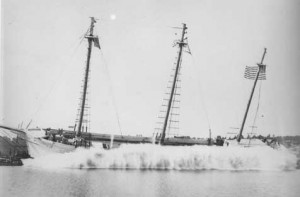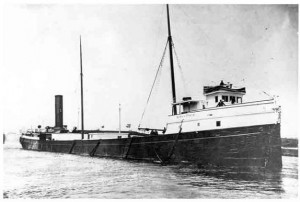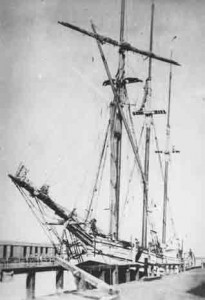Jon Paul’s Maritime Diaries
- Share
- Tweet
- Pin
- Share

Launch of the topsail schooner Cora A. at Burger & Burger shipyard in Manitowoc, less her yards and booms. Photo courtesy of the Thunder Bay Sanctuary Research Collection.
The last column was about one of the first schooner’s built at Manitowoc, the Challenge, which set the standard for schooner design for the 19th century. This column is about the last of the white winged fleet to be built at Manitowoc and the last commercial sail craft built on the Great Lakes. I first looked into the Cora A. a number of years ago when a friend, Chris Olson from Sturgeon Bay, told me his grandmother’s uncle, James Erickson, was owner and captain. Chris’s grandmother, Bessie Erickson, later to be Bessie Palmer, was able to sail a few times on the Cora A. I contacted the National Archives in Washington D.C. and was able to obtain copies of the original enrollments and documentation, and sure enough, James Erickson was a prominent figure in the Cora’s history.
The topsail schooner Cora A. was built in 1889 at Manitowoc by Burger & Burger, with George B. Burger listed as master carpenter builder. Her original measurements were 149 feet in length, 31.5 feet in breadth and 11 feet depth, at 381 gross tons, 361.95 net. She had three masts with a plain head and square stern. The Cora A. was built for William Walsh and P.L. Anten of Chicago, Illinois who were half owners and captained by William Walsh.
She was enrolled at Chicago on July 22, 1889 and would come to Sturgeon Bay on her first trip to pick up lumber at the Island Mill. The first load on the beautiful new schooner would be 500,000 feet of lumber. Coming out of Sturgeon Bay, she would be caught in a dense fog and get stranded in the mud at the entrance to the canal. The tugs Burton, Marinette, and Spalding would pull on the stranded vessel for three hours before releasing her and sending her on voyage to Chicago.

The wooden steamer City of Paris collided with the Cora A. in the worst accident the Cora suffered on the Great Lakes. Photo courtesy of the C. Patrick Labadie collection.
For the sailing season of 1890 the original owners would sell one-fifth of the vessel’s interest to L. S. Heafield of Chicago and name A. Anderson as her captain. On April 18, 1892 the Cora A. was in a collision with the steamer City of Paris during a northeast gale on Lake Michigan; she was in sinking condition, but managed to reach Ludington, Michigan. The next several years she would remain in the lumber business delivering from northern ports to Chicago.
In November of 1894 the Lackawanna liner Arthur Orr, while navigating the Chicago River, had one of its heavy iron hatch covers suspended by its windlass while passing the Cora A., which was docked. The steamer listed and the hatch cover swung and hooked on the Cora’s jibboom; it hung there for a moment before tearing the windlass from the Orr off its deck and fell into the water; the Cora A. received minor damage.
Small accidents like the previous one were common back then, such as in November of 1895 when the small local schooner Lettie May, under the command of Captain Van Dycke, was attempting to dock under sail at the Merchants Dock in Sturgeon Bay. When her jib stay (rigging for the fore topmast) came into contact with the jibboom of the docked Cora A. it broke the topmast of the smaller Lettie May. The May would load hay a few days later and be on her way to Escanaba.

The large jibboom of the Cora A. was involved in at least two of her accidents. Sometimes referred to as the bowsprit, the jibboom actually rests on the bowsprit. Photo courtesy of the Thunder Bay Sanctuary Research Collection.
In January of 1897 William Walsh would take over as sole owner of the Cora A. Captain Anderson would stay on as Master. The Cora A. was a fast vessel and in late October of 1897 Captain Anderson completed a run from Alpena, Michigan to Chicago with a load of lumber in 40 hours, a distance of 437 miles, averaging over 10.5 miles per hour.

The small coastal trader, Lettie May had her main topmast (top of the forward mast) broken from the jibboom of the Cora A. Photo courtesy of the Wisconsin Marine Society.
The Cora would be re-measured in April of 1902. Her new measurements were 146.4 feet in length, 31.5 feet in breadth and 11.2-foot depth, at 370 tons gross, 327 tons net. Although the vessel did not undergo any changes, the way the government measured length did. The government taxed vessels on their net tonnage, and this meant the Cora A. was 35 tons less than her old measurement, which was less to tax. Her new Captain was listed as Olaf Olson.
She was caught in a squall off Manitowoc in mid-November 1908 and broke her main boom. She managed to struggle into port only to find there were no tugs available and dropped her anchor, but it soon parted the cable and once again the Cora A. found herself in a bad situation. Fortunately, a tug saw her predicament and came to her assistance, hooked onto her, and towed her to the shipyard for repairs, lady luck was again on her side. Next column: Part II – The Cora A.’s final years on the lakes, her ocean trade, and demise.
